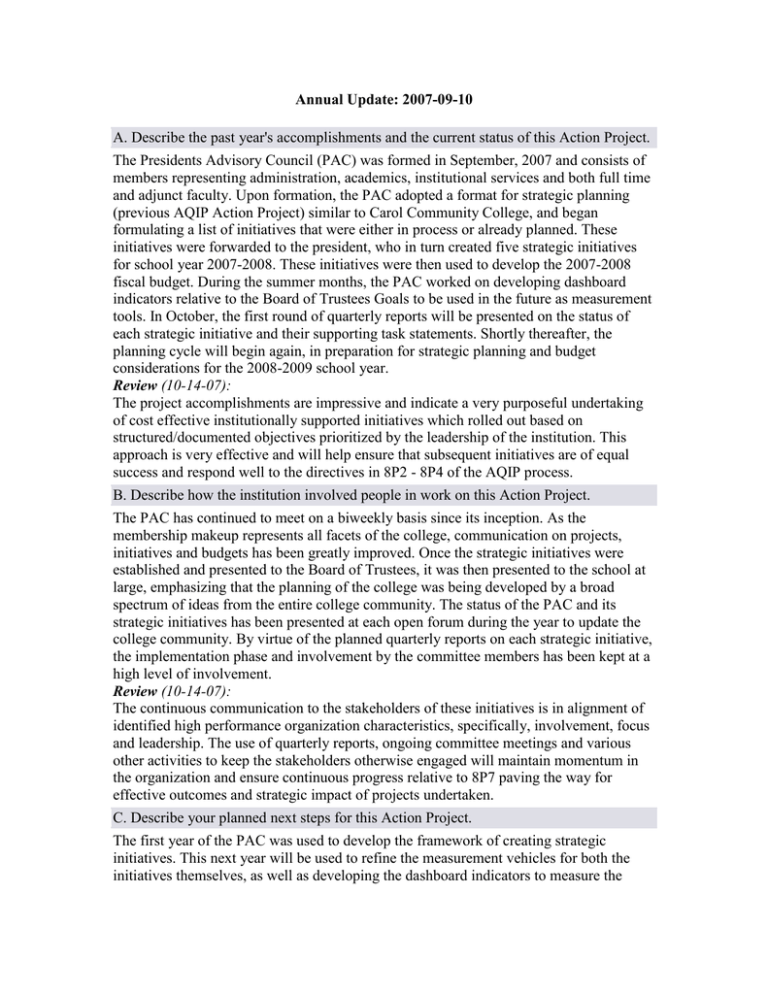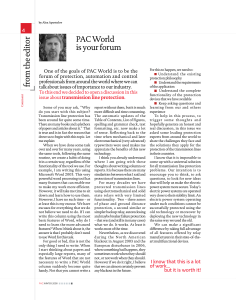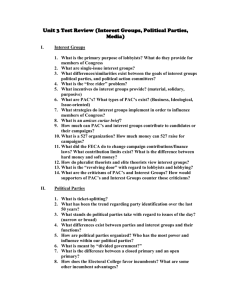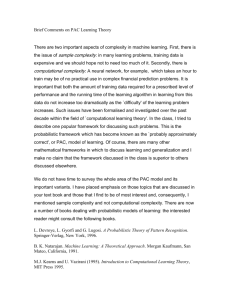2007 Annual Update with Reviewer Response
advertisement

Annual Update: 2007-09-10 A. Describe the past year's accomplishments and the current status of this Action Project. The Presidents Advisory Council (PAC) was formed in September, 2007 and consists of members representing administration, academics, institutional services and both full time and adjunct faculty. Upon formation, the PAC adopted a format for strategic planning (previous AQIP Action Project) similar to Carol Community College, and began formulating a list of initiatives that were either in process or already planned. These initiatives were forwarded to the president, who in turn created five strategic initiatives for school year 2007-2008. These initiatives were then used to develop the 2007-2008 fiscal budget. During the summer months, the PAC worked on developing dashboard indicators relative to the Board of Trustees Goals to be used in the future as measurement tools. In October, the first round of quarterly reports will be presented on the status of each strategic initiative and their supporting task statements. Shortly thereafter, the planning cycle will begin again, in preparation for strategic planning and budget considerations for the 2008-2009 school year. Review (10-14-07): The project accomplishments are impressive and indicate a very purposeful undertaking of cost effective institutionally supported initiatives which rolled out based on structured/documented objectives prioritized by the leadership of the institution. This approach is very effective and will help ensure that subsequent initiatives are of equal success and respond well to the directives in 8P2 - 8P4 of the AQIP process. B. Describe how the institution involved people in work on this Action Project. The PAC has continued to meet on a biweekly basis since its inception. As the membership makeup represents all facets of the college, communication on projects, initiatives and budgets has been greatly improved. Once the strategic initiatives were established and presented to the Board of Trustees, it was then presented to the school at large, emphasizing that the planning of the college was being developed by a broad spectrum of ideas from the entire college community. The status of the PAC and its strategic initiatives has been presented at each open forum during the year to update the college community. By virtue of the planned quarterly reports on each strategic initiative, the implementation phase and involvement by the committee members has been kept at a high level of involvement. Review (10-14-07): The continuous communication to the stakeholders of these initiatives is in alignment of identified high performance organization characteristics, specifically, involvement, focus and leadership. The use of quarterly reports, ongoing committee meetings and various other activities to keep the stakeholders otherwise engaged will maintain momentum in the organization and ensure continuous progress relative to 8P7 paving the way for effective outcomes and strategic impact of projects undertaken. C. Describe your planned next steps for this Action Project. The first year of the PAC was used to develop the framework of creating strategic initiatives. This next year will be used to refine the measurement vehicles for both the initiatives themselves, as well as developing the dashboard indicators to measure the achievement of Board Goals. The PAC will continue its efforts in establishing a well organized method of enhancing long range planning at the college. The model that the PAC chose will soon come full circle, where the process will start anew in developing the direction of the college for the future. Review (10-14-07): The outline presented by the institution for next steps holds promise. The dashboard and measurement tool development initiatives will help the institution obtain key qualitative and quantitative feedback on effectiveness measurements and institutional impacts as well as identify any anomalies that may be indicated. This type of baseline identification can help the institution identify barriers and opportunity areas early on and provide insight for future initiatives so that problems can be avoided especially during evaluation of new initiatives as well as in the early stages of newly executed ones. As it relates to 8P8 the tools identified will aid in further analysis and evaluation of these new processes being implemented. D. Describe any "effective practice(s)" that resulted from your work on this Action Project. The entire planning process at North Central State College has been re-energized by the creation of the President’s Advisory Council. A number of committees that had worked independently have been absorbed into the PAC, which has created a better flow of communication within the college. The continuous process format prevents this planning process from being “shelved” after completion, which had occurred in the past. In addition, the format of the PAC, being comprised of members from all areas of the college, allows for open communication on any and all projects that are being planned or are in process, improving the morale of the college tremendously. Review (10-14-07): The "effectiveness practice" identified is on target and crucial to the ongoing success of this project. Maintaining momentum and finding ways to keep stakeholders informed and otherwise engaged is going to make the difference between continuous improvement or stagnant activity within the institution. Obtaining information from other institutions such as the one mentioned early in the project discussion on what has worked for their initiatives will also help to uncover additional "effective practices" which can be utilized to ensure all of the initial groundwork is not lost. E. What challenges, if any, are you still facing in regards to this Action Project? Although the strategic planning process has been developed and initiatives have been identified, the challenge before the PAC now is to ensure that the assessment portion of the plan is effective. The process will take two full years before being completely utilized, as this coming school year will be used to gather data on the effectiveness of the task statements that were developed to complete the primary strategic initiatives. This challenge is being met by assigning Project Coordinators that are in charge of each initiative, plus assigning Reports that will be responsible for keeping the Coordinators on track. A second challenge is developing a way to handle “off budget” projects that come before the PAC outside of the school’s budget planning cycle. Since the entire process is continuous, plus the fact that some projects can be completed at any time, the PAC is still in the process of formulating a plan to incorporate these type of situations. Review (10-14-07): The institution is being proactive in the identification and implementation of action steps to circumvent the problems that have been identified. Providing accountability within the ranks of the organization is a great start and the checks and balances that are being put into place appear to be relative and should be effective in their utilization. As all initiatives go through the committee which reports directly to the leadership of the institution perhaps a secondary budget for contingencies needs to be established which earmarks additional resources that may be available for "off budget" initiatives that may arise. A contingency allocation should alleviate any issue of where the resources will come from and establishing criteria for those "off budget" processes may provide an opportunity to address and implement some benchmarks to identify criteria to be met before the consideration to either execute or table these for the next round. This could be a priority for the PAC so that this does not become a barrier to continued momentum within the institution. F. If you would like to discuss the possibility of AQIP providing you help to stimulate progress on this action project, explain your need(s) here and tell us who to contact and when? Review (10-14-07):



